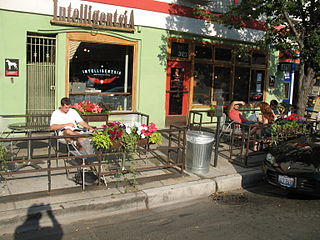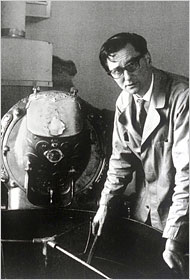
Espresso is a coffee-brewing method in which a small amount of nearly boiling water is forced under pressure through finely ground coffee beans.

A barista is a person, usually a coffeehouse employee, who prepares and serves espresso-based coffee drinks and other beverages.
Peet's Coffee is a San Francisco Bay Area-based specialty coffee roaster and retailer owned by JAB Holding Company via JDE Peet's. Founded in 1966 by Alfred Peet in Berkeley, California, Peet's introduced the United States to its darker roasted Arabica coffee in blends including French roast and grades appropriate for espresso drinks. Peet's offers freshly roasted beans, brewed coffee and espresso beverages, as well as bottled cold brew. In 2007, Peet's opened the first LEED Gold Certified roastery in the United States. Peet's coffee is sold in over 14,000 grocery stores across the United States.

International Coffee & Tea, LLC, doing business as The Coffee Bean & Tea Leaf, is an American coffee shop chain founded in 1963. Since 2019, it is a trade name of Ireland-based Super Magnificent Coffee Company Ireland Limited. Its 80% stake is by multinational company Jollibee Foods Corporation. It operates as an independent subsidiary and remains headquartered in Los Angeles, California.
Matthew Algie is an independent coffee roaster with registered offices at 16 Lawmoor Road, Glasgow, United Kingdom. The company sells its coffee to coffee shops, bars, restaurants, hotels and businesses across the UK & Ireland and also offers coffee machines for hire - supported by a network of field engineers as well as a range of coffee-related equipment and complementary products through its sister-company Espresso Warehouse. Additionally, Matthew Algie also provide SCA accredited barista training courses, taught via their training campuses based in London, Glasgow & Dublin.
Gerald Baldwin is an American businessman. He and two other entrepreneurs, Gordon Bowker and Zev Siegl, founded Starbucks in Seattle, in 1971. He is a Sonoma Valley vintner, and co-founder of J. Baldwin Wines.

Roasting coffee transforms the chemical and physical properties of green coffee beans into roasted coffee products. The roasting process is what produces the characteristic flavor of coffee by causing the green coffee beans to change in taste. Unroasted beans contain similar if not higher levels of acids, protein, sugars, and caffeine as those that have been roasted, but lack the taste of roasted coffee beans due to the Maillard and other chemical reactions that occur during roasting.
Stumptown Coffee Roasters is a coffee roaster and retailer based in Portland, Oregon, United States. The chain's flagship café and roastery opened in 1999. Three other cafes, a roastery and a tasting annex have since opened in Portland, as well as locations in Seattle, New York, and Los Angeles,. Stumptown is owned by Peet's Coffee, which in turn is owned by JAB Holding Company. The company was an early innovator with cold brew coffee in nitro cans and have continued to develop other cold brew product innovations.

Intelligentsia Coffee is an American coffee roasting company and retailer based in Chicago, Illinois. Founded in 1995 by Doug Zell and Emily Mange, Intelligentsia is considered a major representative of third wave coffee. In 2015, Peet's Coffee & Tea acquired a majority stake in the company.

Alfred H. Peet was a Dutch-American entrepreneur and the founder of Peet's Coffee & Tea in Berkeley, California, in 1966. Peet is widely credited with starting the specialty coffee revolution in the US. Among coffee historians, Peet has been called "the Dutchman who taught America how to drink coffee." Peet taught his style of roasting beans to Jerry Baldwin, Zev Siegl and Gordon Bowker, who, with his blessing, took the technique to Seattle and founded Starbucks in 1971. Peet later distanced himself, however, from the Starbucks trio as they experimented with ultra-dark roasts. "Baldwin never learned anything from me," Peet was later quoted as saying.

James Alexander Hoffmann is an English barista, YouTuber, entrepreneur, coffee consultant, and author. Hoffmann first came to prominence after winning the World Barista Championship in 2007 and has since been credited as a pioneer of Britain's third-wave coffee movement. Hoffmann has published three books, including The World Atlas of Coffee, amassed a significant following on YouTube, started several businesses, including the specialty coffee roaster Square Mile Coffee Roasters, and consulted for several coffee ventures.

David Schomer is a co-founder of Espresso Vivace. The Seattle Times said "Schomer is as influential in the gourmet coffee world as Starbucks CEO Howard Schultz is in the mainstream coffee industry."

The Easy Serving Espresso pod, is a small packed coffee pod with a paper filter covering for use in a non-grinding espresso machine. The E.S.E. standard was created by Italian Illy in the 1970s and is maintained by the "Consortium for the Development and the Protection of the E.S.E. Standard." It is open to all coffee roasters and machine manufacturers, making it the self-acclaimed "only open system available to the sector for espresso coffee prepared with paper pods".

Blue Bottle Coffee, Inc., is a coffee roaster and retailer once headquartered in Oakland, California, United States. In 2017, a majority stake in the company was acquired by Nestlé (68%). It is a major player in third wave coffee. The company focuses on single-origin beans.

Café Allegro is a coffeeshop in the University District of Seattle, Washington, United States. It is notable for being one of the city's first espresso shops and for its role in the history of Starbucks, as the place where founding proprietor Dave Olsen designed the Starbucks coffee product line. Situated in an alleyway, the cafe features multiple entrances and rooms.
Seattle is regarded as a world center for coffee roasting and coffee supply chain management. Related to this, many of the city's inhabitants are coffee enthusiasts; the city is known for its prominent coffee culture and numerous coffeehouses.

Union Hand-Roasted Coffee is a privately owned British coffee roasting business based in East London, United Kingdom. The company was founded in 2001 by Jeremy Torz and Steven Macatonia. Coffee House says the company "effectively bridges the definitions of independent and mainstream" as they work according to craft principles while still selling their products in supermarkets.
Starbucks Reserve is a program by the international coffeehouse chain Starbucks. The program involves operation of worldwide roasteries; currently six are in operation. Also part of the program are 28 coffee bars preparing Starbucks Reserve products, what Starbucks considers its rarest and best-quality coffees, usually single-origin coffees. Some Starbucks Reserve coffee is also sold in about 1,500 of the chain's traditional outlets.

Spella Caffè is a coffee shop in Portland, Oregon, United States. Andrea Spella started the business as a cart in 2006, before opening a brick and mortar space in downtown Portland in 2010. The business has garnered a positive reception, and has been cited as an influence for other coffee company founders.

Public Domain Coffee is a coffee shop in Portland, Oregon. Coffee Bean International opened the cafe in 2010.













